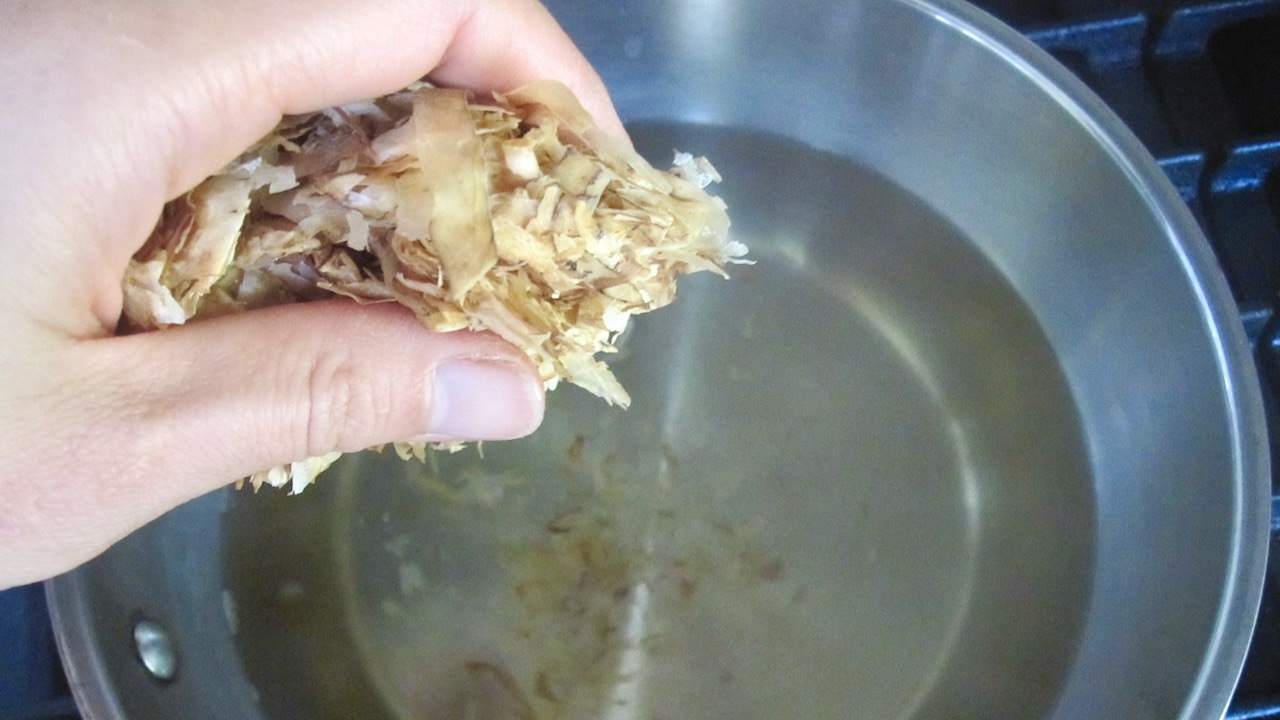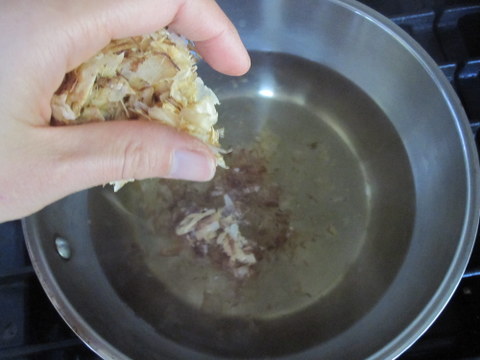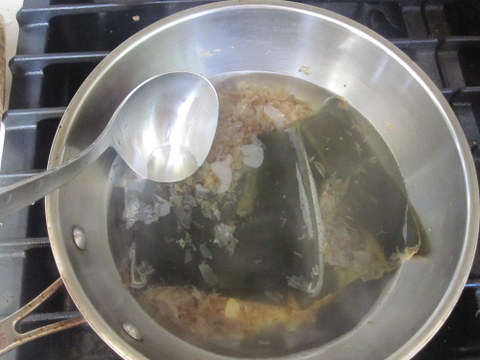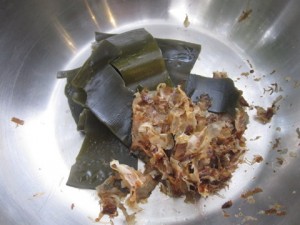The general meaning of dashi is stock with “umami” or savory taste. Japanese use the word dashi not only for Japanese dashi but also any kind of tasty stock such as fondue, bouillon or consommé for French cooking. But for our purposes Japanese dashi is simple clear broth or cooking stock, made by water with any combination of kombu (a type of kelp), katsubobushi / kezurikatsuo (dried bonito flakes), niboshi (dried anchovies), and dried shiitake mushrooms. It is one important meaning of it, but we other way of using the word, dashi. Besides English definition, we use in an expression “the dish has good dashi”. That means the dish has tasty flavor because of a certain ingredient that gave the dish good flavor, umami. The ingredient can be fish, selfish, meat, bacon, dried vegetables or anything can release a good flavor. Japanese believe good tasty dish will always have some sort of ingredient can release umami. The umami will give a good dashi to the dish. I just wanted to clarify about the meaning before I go any further although in this section I will focus more on the English definition.
When I talk about dashi, often times I have a difficulty to explain. I think it is because preparation or meaning of dashi can vary a lot depending on whom you are talking with. It would be different whether a chef is preparing dashi for a restaurant, an older generation home cook is preparing a traditional meal, or a younger generation home cook is preparing a quick casual meal. Although dashi is very important for Japanese cooking, less and less people are preparing dashi in a traditional way. Instead many people choose to use granulated instant dashi powder (like we might use chicken bouillon) simply added to water instead.
I think the main reasons for that is the convenience and the cost. Instant powder is convenient and flavorful in a way, and pretty inexpensive. Unfortunately using kombu and katsuobushi to make dashi can be costly. The bad news about instant powder dashi is that often contain MSG. That’s how they keep the cost down. The instant powder tends to have a lot stronger flavor than real dashi made from scratch. Ironically a lot of people who have grown up with this instant can no longer appreciate nor be satisfied with real dashi.
Now the good news is that more and more companies are making instant dashi powder from real good ingredients as more people are getting knowledge of the quality of food and paying attention to where and how the product was produced for their own health benefits. Basically those better dashi powders are mixture of ground dashi ingredients such as Kombu, katsuobushi, iriko, dired shiitake mushroom, and sold as powder or come in an individual pouch look like a tea bag. They are no longer cheap since the ingredients are real and good, but so much tastier.

Unfortunately they are not easily obtained in the US yet, but if you have an access to good Japanese grocery stores (other Asian grocery stores will probably not carry those good ones), you should be able to buy one of those there. Just remember to ask for “mutenka dashi”. Mutenka means no additives. Other Asian markets and US supermarkets carry only the major brand of instant powder with MSG called Hondashi (meaning real dashi), and this is still one of the largest consumed products even in Japan. If you can’t get to Japanese grocery stores but really interested in, you can always order online from Japanese grocery stores or make your own.
Tyapes of dashi and its preparation methods
There are many different types of dashi, and certain dashi is recommended used for certain types of dish. But there are no really strict rules. Good restaurant tend to use kombu and katsuobushi dashi, but iriko dashi is really popular for home cooking especially for miso soup. One reason is iriko is less expensive. There is not one way or right way of making dashi. Everyone has his own way of making, but there is recommended way of preparation for curtain types of dashi. In this section, I will talk about types of dashi and its recommended preparation methods, and its uses.
- Kombu and Katsuobushi dashi (non vegetarian): dashi made from kombu and katsuobushi.
Method: ichiban, niban and nidashi.
Use: everything, but especially for clear soup, noodle soup and dipping sauce.
This combination is the most popular all purpose dashi. - Kombu Dashi (vegetarian / vegan): dashi made from kombu.
Method: nidashi and mizudashi.
Use: nimono (simmered dish) and nabe (hot pot). - Dried Shiitake Dashi (vegetarian / vegan): dashi made from dried shiitake mushrooms. It is really the soaking water used to rehydrate dried Shiitake mushrooms.
Method: mizudashi or mizudashi followed by nidashi.
Use: everything but especially for the dishes need rehydrate mushrooms. - Katsuo (bushi) Dashi (non vegetarian): dashi made from katsuobushi, dried bonito.
Method: ichiban, niban and nidashi. Use: similar to kombu and katsuobushi dashi. - Iriko (niboshi) Dashi (non vegetarian): dashi made from iriko, dried baby sardines.
Method: mizudashi or mizudashi followed by nidashi.
Use: mainly used for miso soup. One of the most popular dashi for home use. - Awase dashi (can be vegetarian or non vegetarian): dashi made from any combination of above ingredients. Awase means combining.
Method: either mizudashi or nidashi depending on the ingredients. Use: everything.
Explanation of preparation methods
Basically there are two major methods of preparing dashi:
Mizudashi
making dashi by cold brewing. There is no cooking involved in this method. Just soak the dashi ingredients over night.
Nidashi
making dashi by simmering. This includes ichiban dashi and niban dashi. Ichiban and niban dashi are simmering with special care.
And within nidashi (simmering) method, there is two distinctive way of preparing dashi that has its own name for. One is called ichiban dashi (first stock), and the other is called niban dashi (second stock). You do simmer it to prepare them, but with a lot of extra attention for timing when to add ingredients and heat adjustment. The method mostly used for kombu and katsuobushi combination dashi. Although people talk so much about this special preparation, it doesn’t work at home as well as at a restaurant. When you are preparing huge amount of dashi, you can get pretty good second stock from that. But at home unless you really need ichiban stock for certain dish, there is not much good reason to separate ichiban and niban stock. I will talk about how to prepare them because it is nice to know. But you could just simply simmer kombu and katsuobushi, which has the recipe below under “kombu and katsuobushi dashi by simmering”.
- Ichiban dashi
means first (primary) dashi, which is made with unused ingredients, and more delicate in preparation, flavor and color than niban dashi. The very short cooking time will keep the stock clear and extract the best subtle flavor of kombu and katsuobushi. Do not squeeze the stock out through, which would make the stock cloudy. They are mainly used in the dishes such as clear broth soup and Chawanmushi where you can appreciate its delicate flavor and its color. - Niban Dashi
means second dashi, which is made with used ingredients for preparation of ichiban dashi. At this time cook longer with low heat to obtain the rest of flavor from the used ingredients slowly. As a result, the flavor, the smell and the color stronger and more intense. You could squeeze lightly after straining to get extra stock. This is all purpose dashi.
RECIPES
All dashi can be used immediately or keep it in the refrigerator for up to 4 days. You could also freeze it for 3 months.
1 Kombu & Katsuobushi dashi by Ichiban dashi method (non vegetarian)
Ingredients:
- 4 cups of water
- 0.4-0.6 oz of Komb: about 1/2 cup to 3/4 cup small square sized kombu. Cut kombu to see how much kombu you need at first time, but otherwise you don’t have to cut kombu to make dashi.
- 1 to 1 1/2 cup loosely packed katsuobushi
Note
The amount of ingredients don’t need to be precise. Dashi flavor can be very flexible. I noticed the dashi recipes in Japan have more katsuobushi and less kombu than typical dashi recipes here. Katsubobushi gives more fishy smell, and Japanese people like that way more. If you like that way, go ahead use an extra katsuobushi up to even 2 cups and use less kombu (0.4 oz) or not. If you don’t like katsuobushi at all, try to make just with kombu, called kombu dashi.
Preparation:
- Wipe the komb with a slightly wet clean cloth to get rid of dust, but do not wash it otherwise all the good flavor will get lost. The white powder appeared on the surface of komb is a sweet carbohydrate that is a source of umami, so do not get rid of it.
- Place water and kombu in a saucepan over medium heat until right before the water boils, and remove the kombu. Ideal time for this process is about 10 minutes so adjust your heat accordingly.
Note: Keep the kombu if you are making second dashi, otherwise discard it, use in a different recipes, or simply eat it with or without soy sauce. I never through it away because of the great nutrition. - Add the katsuobushi to the pot, and wait until the water boils again (this it going to be very quick). Turn the heat, and let it set until the katsuobushi sink in a few minutes or simply wait for a few minutes. If the water is boiling already before adding the katsuobushi, add one tablespoon of water to stop it.
Some people skim foams that rise to the surface after turning the heat off. The foam is called aku, which is bitterness or odd smells come from produce. Japanese are really big on getting rid of aku, but you don’t have to do. You might not even see the form. This is more important when you are making dashi with dried fish or dried mushrooms, which contains more aku. - Strain the stock through a strainer lined with a paper towel, a coffee filter or a cotton cloth. Do not squeeze the katsuobushi otherwise the stock gets cloudy and fishy.




2 Kombu & Katsuobushi dashi by Niban dashi method (continued from ichiban) (non vegetarian)
Ingredients:
- 4 cup water
- Kombu and Katsuobushi used to make ichiban dashi (above)
- Small handful of katsuobushi (optional)
Preparation:
- Place all the ingredients in a saucepan over medium high heat until the water boils, and turn the heat down to low and simmer for 10 minutes.
- Turn the heat off, and at this point add a small handful of katsuobushi if you want to add an extra flavor but not necessary. Let it set until the katsuobushi sink in a few minutes or simply wait for a few minutes. As I described in first stock, at this point some people would skim forms (aku) that rise to the safe off after turning heat off.
- Strain the stock through a strainer lined with a paper towel, a coffee filter or a cotton cloth. Wrap the solids, and squeeze it gently to obtain an extra stock.


3 Kombu & Katsuobushi dashi by simmering (combination of ichiban and niban tequnick) (non vegetarian)
This is dashi made by simply simmering without paying attention to ichiban or niban dashi. Unless you really need ichiban dashi and niban dashi, this is more convenient way of preparing dashi. Use the same ingredients as making ichiban and niban dashi, but increase the amount a little.
Ingredients:
The amount of ingredients don’t need to be precise. Dashi flavor can be very flexible.
- 4 cups of water
- 0.6 oz of Komb: 3/4 cup small square sized kombu. Cut kombu to see how much kombu you need at first time, but otherwise you don’t have to cut kombu to make dashi.
- 1 ¼ to 1 ½ cup loosely packed katsuobushi
Preparation:
- Wipe the komb with a slightly wet clean cloth to get rid of dust, but do not wash it otherwise all the good flavor will get lost. The white powder appeared on the surface of komb is a sweet carbohydrate that is a source of umami, so do not get rid of it.
- Place water and kombu in a saucepan, and soak the kombu for 30 minutes.
- Heat the saucepan over medium heat until the water boils. Ideal time for this process is about 10 minutes so adjust your heat accordingly. Continue cooking for 1 minutes, and remove the kombu. *The kombu can be reused in a different recipes, or simply eat it with or without soy sauce. You could discard it, but even used kombu still has good nutrition.
- Add ¼ cup water to stop the water from boiling, and add the katsuobushi to the pot. Wait until the water boils again, and lower the heat. Continue cooking for 2 minutes or longer for more intense flavor.
- Turn the heat, and let it set until the katsuobushi sink in a few minutes or simply wait for a few minutes.
- Strain the stock through a strainer lined with a paper towel, a coffee filter or a cotton cloth. Wrap the solids, and squeeze it very gently to obtain an extra stock unless clear dashi is needed.
4 Kombu Dashi by mizudashi (vegetarian / vegan)
Kombu dashi is used mostly in nabe (hot pot), sunomono (vinegared dish ), nimono (simmered dish) at home. This vegetarian dashi is also very important dashi for Shojin ryori (Buddhist cuisine).
Ingredients:
- 4 cups of water
- 1 oz of Komb: about 1 1/4 cup chopped into small square sizes. You can cut kombu to see how much kombu you need at first time, but otherwise you don’t have to cut combu.
Instruction:
- Wipe the komb with a slightly wet clean cloth to get rid of dust, but do not wash it otherwise all the good flavor will get lost. The white powder appeared on the surface of kombu is a sweet carbohydrate that is a source of umami, so do not get rid of it.
- Place water and the kombu in a large bowl, and soak the kombu for overnight and remove. The soaking water is now ready to use as dashi. Use immediately or keep it in the refrigerator for up to 4 days. You could also freeze it for 3 months.
Note: Komb can be used in different recipes, or simply eat it with or without soy sauce. I never through it away because of the great nutrition.
5 Iriko (Niboshi, Ago) Dashi by nidashi (non vegetarian)

This is dashi making from typically small dried sardines called niboshi or iriko, but sometimes made with different dried fish called ago. Whatever the dried fish you have, the preparation is the same. This is a very popular every day dashi especially for miso soup. It’s easy to make, and also this is the at least expensive way of making dashi from scratch. You can use this dashi almost for everything except dishes that fish is the main ingredient such as simmered whole fish. Depending on the fish, the flavor and taste of the fish and iriko dashi might fight.
Ingredients:
- 4 cup water
- 15g / 0.5oz or more iriko (niboshi) *about 7 medium size niboshi (2.5 inch long)
Instruction for nidashi (simmering)
- Break off the head and stomach of iriko if you like or use the entire iriko. Some people like the bitterness from it, or not. Roast the iriko in a skillet for a few minutes helps to reduce the fishy smell, but this is optional also.
- Place the iriko in a saucepan, and cover with water and soak for at least 30 minutes.
- Bring the water to a boil over medium heat, and cook for 3 minutes as skimming off foams that rise to the surface. Remove the iriko.
Instruction for mizudashi (cold brew)
- Place the iriko in a bowl, and cover with water and soak for 4 hours to over night. Remove the iriko, and the soaking water is ready to use as dashi. *No need for breaking off the head and stomach nor roasting for cold brew.
6 Dried Shiitake Dashi by mizudashi (vegetarian / vegan)
This is basically the soaking water used to rehydrate dried Shiitake mushrooms. The water has good earthy flavor, and good to use as dashi for almost every kind of dish. There are many different way of rehydrating dried Shiitake, but the best way to get full flavor is soaking water for at least 3-4 hours to over night. Using hot water will make the process quicker (soak for about 20 minutes), but sometimes add bitterness to it. Slow process is really recommended, but you can use hot water or microwave method also when you are in a really hurry.
Ingredients:
- 4 cup water
- 30g / 1oz dried Shiitake mushrooms, *about 6 medium size
Instructions for mizudashi (cold brew)
Place the mushrooms in a bowl, and cover with water and soak for 3-4 hours until it gets soft.
Remove the mushroom from the water, and reserve it to use for any dished you like. The soaking water is ready to use as dashi, but the following process is recommended if you want to take some extra bitterness. Bring to a boil over medium heat, and skim off foams that rise to the surface. Remove the mushrooms, and ready to use.
Instructions for microwave
- Place the mushrooms in a bowl, and cover with warm water, and heat in a microwave for 4-5 minutes until it gets soft.
- Place the soaking water in a saucepan, and bring to a boil over medium heat. Skim off foams that rise to the surface, and remove from heat. The soaking water is ready to use as dashi, but the following process is recommended if you want to take some extra bitterness. Bring to a boil over medium heat, and skim off foams that rise to the surface, and remove.
7 Kombu and Dried Shiitake mushroom dashi (vegetarian / vegan)
This is a good option for vegetarian. Simply soak the kombu and Shiitake in water for over night.
I think now we are all done talking about dashi. This is pretty much all about dashi you need to know. I know it is a lot of information and also little confusing, but there is not really right or wrong way of preparing dashi. At this point you might want to try some of the dashi recipes I gave you, and try to figure out which dashi flavor you like the best. And just stick with it or you might want to combine ingredients to create your own combination of dashi.
In my next post I will talk about my preference of dashi.


 Kinpira Gobo
Kinpira Gobo
Leave a Reply